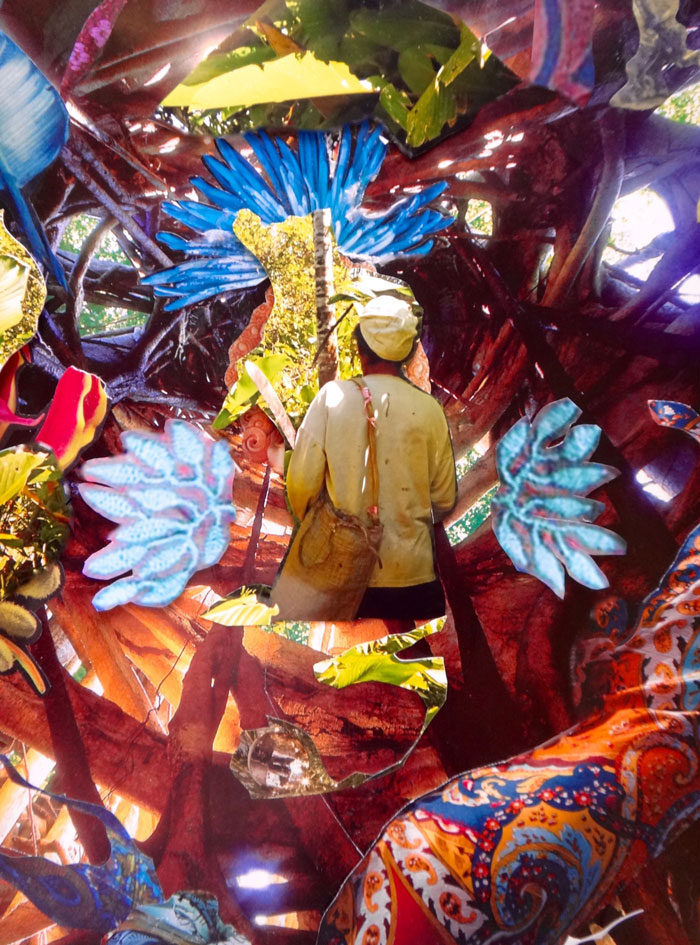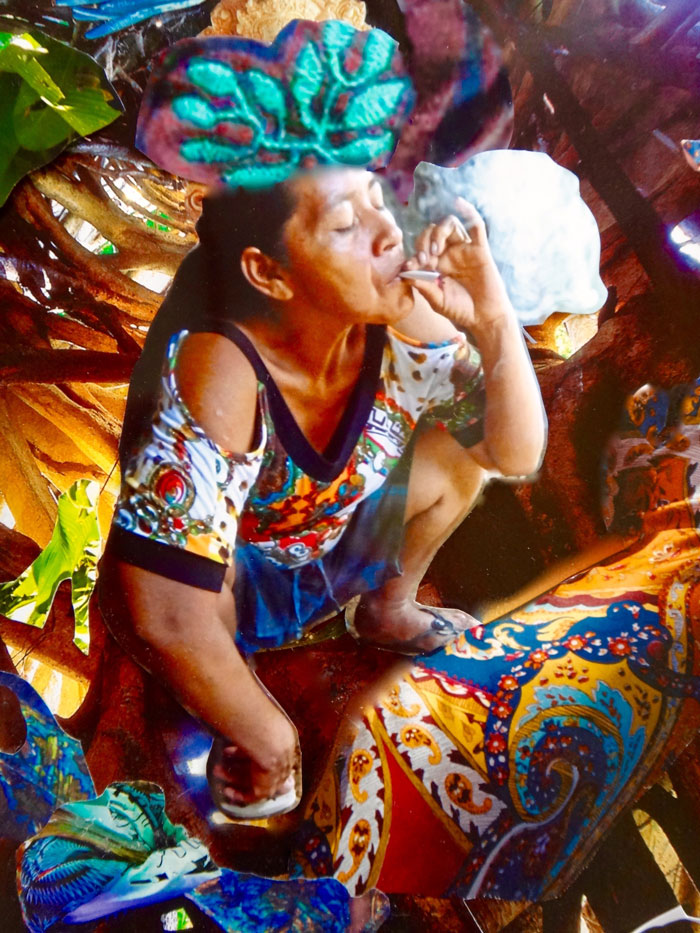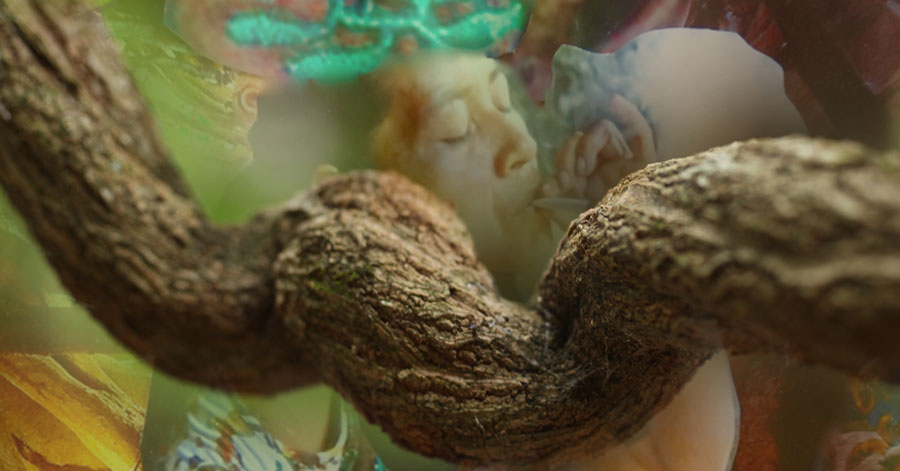- How Indigenous & Black People are Fighting Colonialism in the Academy - September 2, 2020
- How Feminine is Ayahuasca? - November 21, 2016
While doing fieldwork with traditional healers in the Peruvian Amazon,1 I realized that their way of understanding nature was profoundly embedded within the categories of male and female. Humanity was only one possible expression of this gendered pluriverse. The forest and the cities of the forest were made of people, objects, plants, animals, and other-than-human beings with different gendered identities defined by deep cultural traditions.
Yet, with the recent influx of ayahuasca tourists seeking the “mother” ayahuasca brew, the traditional gender understanding is being turned upside-down. In this space of transformation, local women healers seem to gain more opportunities in the gendered pluriverse.

Doña Alicia from San Pedro island. Artist: Nicole Washburn
Before I tell you about one indigenous Peruvian woman’s journey of healing locals and tourists, let’s consider this traditional gendered reality of plants. One thing that is certain is that it is complex.
“In general, male curanderos (healers) tend to work with palos or “woods,” and female curanderas are inclined to work with hierbas or “herbs”,”
Despite the enormous diversity of male and female beings, or “presences,” of the plant world, it was possible for me to identify certain patterns. Two terms appeared constantly among the healers I was researching in Tamshiyacu, a small village near Iquitos. They are palos, which we can translate as “woods,” and hierbas, which are “herbs.” Each word, however, was a kind of world and defined a specific path between humans and the universe of plants.
In general, male curanderos (healers) tend to work with palos or “woods”, and female curanderas are inclined to work with hierbas or “herbs.” The gender of a healer defines his or her relationship with the pluriverse of the plant kingdom. Existing as relatively independent universes, the palos and the hierbas connect transversally the plants, the human realm, and the other-than-human presences of the forest.
These presences, or beings, dwell in diverse families of dueños, or “owners,” of the plants, and, although these mysterious presences exist in invisible realms, they also may be experienced through the ordinary senses of smell, touch, and taste. Is there not a visible incongruity? Why, if males work with masculine plants and females work with feminine plants, and the sacred vine ayahuasca is understood as a feminine spirit, are the healers who work with ayahuasca mostly male?
This is the tension that I want to consider. But first, let us go over the nature of these two dimensions. Different styles of humanity are expressed in the geographic locations where palos and hierbas grow and propagate. The hierbas are usually grown near houses, gardens, squares, and parks, closely related to women, the elderly, and children. Objects of domestic care and maternal fostering, they belong to a nature that is in a permanent process of bonding to the families that nourish them. Some examples of hierbas are malva (Malachra ruderalis), algodón (Gossypium barbadense) and cordoncillo (Piper aduncum). These plants, usually small to medium in size, tend to have a smooth consistency to touch and a soft or simple taste. They accompany feminine activities such as pregnancy, birth, and breastfeeding. Also, they prevent and treat illnesses that are not inflicted by other humans, a local category of afflictions known as males de Dios or “God’s misfortunes.”
“Many of the palos may induce altered states of consciousness, in strong or mild ways.”
On the opposite side, the texture of the palos is usually wrinkled, and its consistency hard. Barks, woods, and vegetal crusts are related to the forest, growing usually far away from the houses, the gardens and the cultivated spaces. The palos are linked to the world of mystery of what is not sufficiently known, and they are harvested in expeditions that can last one or more days of travel inside the forest. Palos are mostly ingested by men, but also by women and children who are going through critical periods in their lives.
Many of the palos may induce altered states of consciousness, in strong or mild ways. The palos are linked to the treatment of males de gente, “people’s misfortunes,” disturbances produced by other people, and are related to the world of harming agencies. Palos are connected to magic, daño and witchcraft. Some examples of palos are tobacco (Nicotiana tabacum), mucura (Petiveria alliacea) and ayahuasca (Banisteriopsis caapi). Yes, ayahuasca belongs to the masculine world of the palos.
The distinct relationship of a healer with the world of palos and hierbas certainly defines the particular style and possibilities of their occupation. For a woman, dealing with palos is taboo. For a man, it is the same with the hierbas. This opposition happens to be the norm, and normative behaviors are held together by common sense and everyday respect. But, an automatic correspondence between palos with male healers and hierbas with female healers is not always the case.
The story of Isabel offers one such perplexity. Isabel is a Shipibo curandera who lives in Tamshiyacu, a couple of days travel by boat from the community where she was born. Isabel learned to work with palos, and not hierbas. She grew up in her community, but, when her children were grown enough, she decided to travel to a city in the mountains of Peru, far away from home.
“The plant ointments that Isabel prepares for people are oriented towards getting a lover, breaking a witchcraft spell, or working to alleviate the pain of past traumatic memories.”
When she came back to the Amazon five years later, she brought her youngest children to live with her. She started singing her Shipibo icaros (traditional songs) in a center that offered ayahuasca ceremonies for tourists. Her voice became her vehicle and her practice of dietas an exercise for gaining deeper knowledge of vegetalismo shamanism. Isabel redefined her gendered frontiers by her daily practice with the magical and therapeutic properties of ayahuasca and other palos. She claims that she “does not like at all” to work with hierbas; they are simply “not for her.”
The plant ointments that Isabel prepares for people are oriented towards getting a lover, breaking a witchcraft spell, or working to alleviate the pain of past traumatic memories. She heals and attends tourists and local people, defining different understandings for what an illness might be for locals and tourists. As a migrated indigenous women working in the context of shamanic tourism in the contemporary Amazon, she deals with diversity, transformation, and diasporic hybridity in each of her incantations.

Doña Isabel Pinedo from Tamshiyacu, Peru. Artist: Nicole Washburn
Isabel´s inclination to work with palos might be due to a greater personal connection with this universe of vast trees and strong perceptions. Along with that, it cannot be disregarded that she is performing this practice in a context where the cultural transformation promoted by shamanic tourism is challenging the gendered division of nature.
In broader terms, there is an undeniable exploration of the human-to-human and of the human-to-plant matrix that is linked to shamanic tourism and that is related to centuries of colonialism, a history invested in the expansion and domestication of the Amazon frontier. However, this complex cultural process is also influencing healers who are exploring other possibilities beyond the traditional gendered divisions of the world. Breaking the pattern of the exclusive relationship of women with hierbas certainly amplifies the possibilities of connecting with different plants and, therefore, with different types of cures and people.
“We cannot predict the consequences that this feminization of the ayahuasca plant might have for local people”
As the ayahuasca plant is increasingly seen as a feminine spirit by Westerners seeking female shamans, Isabel is drawn to hold an ambiguous position in her local worldview. Should she turn to join the group of the hierbas, and cultivate herself and her practice in the domestic gardens like her tradition has defined? Or, now that women healers in the tourist lodges are increasingly using ayahuasca, will the palo ayahuasca become an everyday “feminine” medicine of the local domestic sphere?
We cannot predict the consequences that this feminization of the ayahuasca plant might have for local people and for the plants themselves. It could indeed completely change past patterns of gendered interactions. For now, the feminization of ayahuasca appears to be giving women more space to expand their knowledge and practices beyond the tamed nature of the domestic sphere and, at the same time, to challenge the taboo of women performing activities involving palos.
The connection that Isabel builds on a daily basis with this group of plants might be a small shift within the forest’s huge array of gendered interconnections; but, her trajectory, and those of other such women, are right now affecting the therapeutic strategies, human-plant bonds, and gender constellations of this vast pluriverse.
- Echazú Boschemeier, A. G. (2015). Corpo de planta: terapias e magias dxs curiosxs da baixa Amazônia do Peru, sob uma perspectiva situada de gênero e de saúde popular [Body of the plant: Therapies and dxs curiosxs spells of lower Amazon from Peru, under a located perspective of gender and popular health (Doctoral dissertation). University of Brasilia. ↩
Take a minute to browse our stock:
Did you enjoy reading this article?
Please support Chacruna's work by donating to us. We are an independent organization and we offer free education and advocacy for psychedelic plant medicines. We are a team of dedicated volunteers!
Can you help Chacruna advance cultural understanding around these substances?














